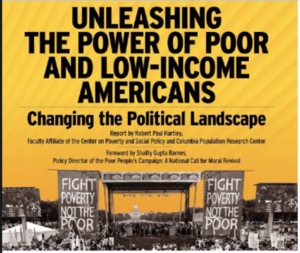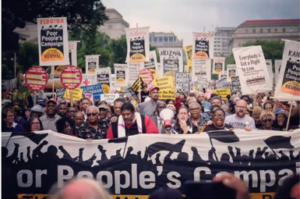By Coner Segren
The power of low-income voters was on display at the latest virtual installment of the Tendaji Talks held Oct. 13.
During the 2016 presidential election, for example, the total number nationally of low-income voters was about 63 million.
Of these, only 29 million voted, while 34 million stayed home. In Michigan during 2016 the PPC website estimates that in 2016 there were 980,000 low-income non-voters in the state. The margin of victory in the state’s election was 1.1%.
These were among data points presented by representatives from the Poor People’e Campaign (PPC) to the Zoom conference. They also reviewed challenges facing low-income voters and highlighted the potential power of this key bloc of voters.

The Poor People’s Campaign is a non-partisan group that advocates for low-income voters, as “agents of change in not just one election, but at the very heart of this democracy,” according to their website.
 The PPC presentation was hosted by Judy Alexander of Neighborhoods Without Borders; the presenters were Shailly Barnes, policy director of the PPC, and Carlyle Stewart, an organizer with the campaign.
The PPC presentation was hosted by Judy Alexander of Neighborhoods Without Borders; the presenters were Shailly Barnes, policy director of the PPC, and Carlyle Stewart, an organizer with the campaign.
The PPC was launched in 2018 on a nationwide scale, with state-based campaigns in 41 states and Washington D.C., with the goal of uniting those “directly affected by these injustices, alongside clergy, labor organizers, activists, and others,” according to the PPC report.
“The goals of the Poor People’s Campaign, the goals that are the same as when we launched and will be the same until we win, are to change the narrative around poverty, systemic racism, ecological devastation, militarism, and the false moral narrative around religious nationalism,” Barnes said. “It’s to build the power of poor and impacted people.”
Barnes said many of the demands of the PPC can be traced back specifically to many of the struggles facing residents of Michigan and Flint, in particular. “Some of the demands around water, around emergency management, around welfare, around work, they come directly out of what we have learned from folks in the state of Michigan.”

Income inequality has increased dramatically over 30-year period
The PPC report estimates that on the national level there are approximately 140 million low-income Americans, who were poor or one emergency away from being poor.
More than 38.5 million of these are children. The 140 million also includes people across all racial groups, age, and ethnic groups.
In Michigan, 35% of residents are poor or low-income, roughly 3.5 million people. The report also shows that over a period from 1979 to 2012, the top 1% of earners in the state saw their incomes increase by 115% while income for the bottom 99% fell by 17%.
“On the other side of the 140 million, there were three people who owned as much wealth as half of the country,” Barnes said, referring to Jeff Bezos, Bill Gates and Warren Buffet, who collectively own nearly $350 billion dollars in wealth compared to around $250 billion for the bottom 50% of the country, according to the report. “On the other side of poverty, there’s this concentration and accumulation of great wealth and power.”
These trends have only been exacerbated by the coronavirus pandemic and recession. At the national level, billionaire wealth has grown by $845 billion in the last six months. This comes at the same time that unemployment that national unemployment for households making less than $50,000 has skyrocketed from 6.5% in August 2019 to 15% in August 2020.
Obstacles for low-income voters
Many challenges face low-income voters wishing to vote, Barnes asserted. Since 2010, there has been a proliferation of voter suppression laws passed in 23 different states, including nearly every southern state, with a further 13 states having at least proposed voter suppression laws, according to a map provided during the presentation. These laws included racial gerrymandering, with the electoral map in North Carolina having been recently struck down by the courts for targeting “black communities with surgical precision, that was the court’s language, they knew exactly who they were targeting and why,” according to Barnes.

Photograph provided by Tendaji presentation.
Michigan was not included on this map. Barnes, however, stressed that due to emergency manager laws passed during the Rick Snyder administration, Michigan could easily qualify as having engaged in voter suppression.
Another major obstacle for low-income and poor voters is lack of healthcare, Barnes stated. Among eligible voters with family incomes above 200% of the poverty line, 10% reported that illness or disability kept them from the polls. Among eligible voters under 200% of the poverty line, that number shot up to 17%.
What low-income voters can do to exercise their power
Carlyle Stewart said that that the main focus of the PPC now is on building the power of low-income voters and organizing people to accomplish that.
“As the campaign is organizing in 45 states across the country, what we’re trying to is influence policies and elections through [the power of low-income voters],” he said. “All the organizing that we are focusing on now is just trying to let people know not only that they have power but to organize people to act on that, to understand that they can make a difference.”
Those interested in contributing to the PPC can sign up to phone bank or text bank to help get out the vote. The Michigan PPC also is seeking citizens to become poll monitors, to help watch the polls on election day. Information on signing up and training sessions can be found at https://vote.poorpeoplescampaign.org/
Other key findings in the report related to voting
- Low-income eligible voters are about 22 percentage points less likely to vote in national elections than those with higher incomes, yet both groups follow similar trends including a roughly 10-percentage-point increase in voting rates for the last midterm election.
- Regardless of income status, about one quarter of eligible voters do not participate in elections because they are not interested in the candidates or campaign issues, or they feel their vote would not matter. Moreover, low-income individuals are less likely to vote because of illness, disability, or transportation issues.
- An increase of at least 1 percent of the non-voting low-income electorate would equal the margin of victory for Michigan in 2016, or a 4 to 7 percent increase in states such as Florida, New Hampshire, Pennsylvania, or Wisconsin.
- Low-income eligible non-voters make up about one fifth of the total electorate in states like Arkansas, Kentucky, Mississippi, New Mexico, Oklahoma, Tennessee, and West Virginia, or in several more states for midterm election years.
- If low-income voters participated at similar rates as higher-income voters, a simple majority (51 percent) of these new voters could flip the 2016 Michigan election results. A total of 15 states could flip decisions if a majority of at least 71 percent, on average, voted differently from the winning candidate (10 from red to blue, or 5 from blue to red).
- Voting by mail represents a quarter of all votes cast, is increasingly common across personal characteristics and income status, and has been strongly bipartisan in state implementation.
The Tendaji Talks, named to honor the late UM – Flint director of Educational Opportunity Initiatives Tendaji Ganges, aim to help Flint area residents learn about their diverse neighbors, local issues caused by racism, and the impact of racism on neighbors, as described at https://fpl.info/tendaji-talks/.
EVM Staff Writer Coner Segren can be reached at csegren@gmail.com.


You must be logged in to post a comment.